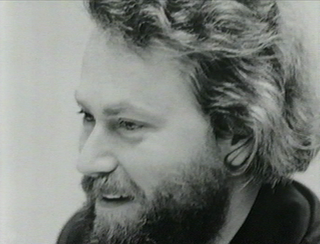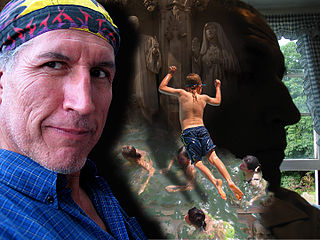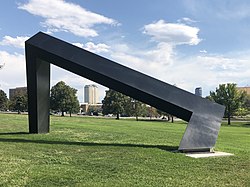
Donald Clarence Judd was an American artist associated with minimalism. In his work, Judd sought autonomy and clarity for the constructed object and the space created by it, ultimately achieving a rigorously democratic presentation without compositional hierarchy. He is generally considered the leading international exponent of "minimalism", and its most important theoretician through such writings as "Specific Objects" (1964). Judd voiced his unorthodox perception of minimalism in Arts Yearbook 8, where he says, "The new three dimensional work doesn't constitute a movement, school, or style. The common aspects are too general and too little common to define a movement. The differences are greater than the similarities."

The Denver Performing Arts Complex in Denver, Colorado, is one of the largest performing arts centers in the United States. The DCPA is a four-block, 12-acre (49,000 m2) site containing ten performance spaces with over 10,000 seats connected by an 80-foot-tall (24 m) glass roof. It is home to a professional theater company and also hosts Broadway musical tours, contemporary dance and ballet, chorales, symphony orchestras, opera productions, and pop stars.

Jerry De La Cruz is an American fine artist born and raised in Denver, Colorado. He currently works out of his studio in the Santa Fe District in Denver, Colorado, and out of his studio in the Little River District in Miami, Florida.
Charles Albert Ginnever, also known as Chuck Ginnever, was an American sculptor, known primarily for large-scale abstract steel sculptures that defy simple understanding, as the works seem to constantly change form as one moves around them in time and space.
Peter Forakis was an American artist and professor. He was known as an abstract geometric sculptor.
Linda Fleming is an American sculptor and university professor. She is currently teaches at California College of the Arts (CCA). She lives and works in Benicia, California, as well as maintaining studios and homes in the Smoke Creek Desert in Nevada, and in Libre, Colorado.

The Lloyd M. Joshel House, also known simply as the Joshel House, is a private residence in the Hilltop Neighborhood of Denver, Colorado. Built in 1951, it is known as one of the finest examples of the International Style in residential architecture in Denver. The property is a local City of Denver Landmark and is listed in the National Register of Historic Places.
Roger Allen Kotoske (1933–2010) was an American sculptor, painter and educator.

Lawrence Argent was a visual artist best known for his 2004 public artwork I See What You Mean at the Colorado Convention Center in Denver.

Mel Tanner was an American light sculptor, painter, installation artist, and videographer. His wife, Dorothy Tanner, was an American light sculptor, installation artist, musician, videographer, and spoken word artist based in Denver, Colorado. The couple worked very closely for over 40 years. Their main project was the creation of Lumonics that consists of their light sculptures, live projection, video, electronics, and music as a total art installation. Author and art historian, Michael Betancourt, described this visual music performance work as a Gesamtkunstwerk in his book, The Lumonics Theater: The Art of Mel & Dorothy Tanner, published in 2004.

Los Seis de Boulder were six Chicano activists and students killed in two car bombings in Boulder, Colorado. The bombings occurred at the end of May 1974, with the name Los Seis de Boulder coined posthumously. The students were protesting the negative treatment of Mexican-American students at the University of Colorado, Boulder at the time of their death. Memorials to the bombing victims have been installed on the University of Colorado campus and in Chautauqua Park.
Catherine Widgery is an American artist. Widgery is known for both her studio-based sculpture work and her public sculpture.

National Velvet is a sculpture by John McEnroe, installed at the base of Denver's 16th Street Pedestrian Bridge, in the U.S. state of Colorado.

Lao Tzu is a 1996 sculpture by Mark di Suvero, installed at Denver's Acoma Plaza at West 13th Avenue, in the U.S. state of Colorado.

Indeterminate Line is a 1987 oxidized steel public art sculpture by Bernar Venet installed in Beverly Hills, California. A later 2004 Cor-ten steel version is installed outside Denver's Colorado Convention Center at Speer Boulevard, in the U.S. state of Colorado. It was installed at a cost of US$600,000. The 33-foot sculpture takes the form of a linear torqued circle.

Bridge is a sculpture by Stephen Shachtman, installed in Denver, Colorado, United States.

Balloon Man Running is a 12-foot (3.7 m) tall sculpture by Sean O'Meallie, installed at Denver's Central Park station, in the U.S. state of Colorado.
Sun Silo is a sculpture by Patrick Marold, installed in Denver's Community Park at East Lowry Boulevard and Pontiac Street, in the U.S. state of Colorado.

Sarah McKenzie is an American painter born in Greenwich, Connecticut. She has had numerous solo exhibitions, most notably with Denver's David B. Smith Gallery, New York's Jen Bekman Gallery, and the Indianapolis Museum of Contemporary Art. Her paintings have been included in group exhibitions at the Walker Art Center, the Carnegie Museum of Art, the Yale School of Architecture, the New Mexico Museum of Art, the Museum of Contemporary Art Denver, and the Aspen Art Museum.














